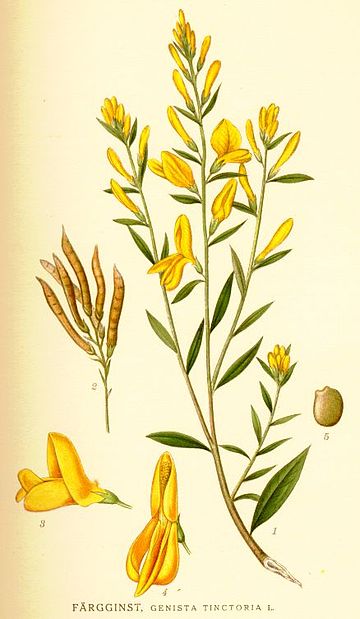Genista tinctoria, the dyer's greenweed[1] or dyer's broom, is a species of flowering plant in the family Fabaceae. Its other common names include dyer's whin, waxen woad and waxen wood. The Latin specific epithet tinctoria means "used as a dye".[2]
| Genista tinctoria | |
|---|---|
 | |
| Illustration from Bilder ur Nordens Flora | |
| Scientific classification | |
| Kingdom: | Plantae |
| Clade: | Tracheophytes |
| Clade: | Angiosperms |
| Clade: | Eudicots |
| Clade: | Rosids |
| Order: | Fabales |
| Family: | Fabaceae |
| Subfamily: | Faboideae |
| Genus: | Genista |
| Species: | G. tinctoria |
| Binomial name | |
| Genista tinctoria | |
| Synonyms | |
|
List
| |
Description
It is a variable deciduous shrub growing to 60–90 centimetres (24–35 in) tall by 100 cm (39 in) wide, the stems woody, slightly hairy, and branched. The alternate, nearly sessile leaves are glabrous and lanceolate. Golden yellow pea-like flowers are borne in erect narrow racemes from spring to early summer. The fruit is a long, shiny pod shaped like a green bean pod.[3]
Distribution and habitat
This species is native to meadows and pastures in Europe and Turkey.[4]
Properties and uses
Numerous cultivars have been selected for garden use, of which 'Royal Gold' has gained the Royal Horticultural Society's Award of Garden Merit.[5][6]
The plant, as its Latin and common names suggest, has been used from ancient times for producing a yellow dye, which combined with woad also provides a green colour.[4]
It was from this plant that the isoflavone genistein was first isolated in 1899; hence the name of the chemical compound. The medicinal parts are the flowering twigs.
The plant has been used in popular medicine and herbalism for various complaints, including skin diseases, even in modern times.[7][8][9]
Gallery
References
External links
Wikiwand in your browser!
Seamless Wikipedia browsing. On steroids.
Every time you click a link to Wikipedia, Wiktionary or Wikiquote in your browser's search results, it will show the modern Wikiwand interface.
Wikiwand extension is a five stars, simple, with minimum permission required to keep your browsing private, safe and transparent.



